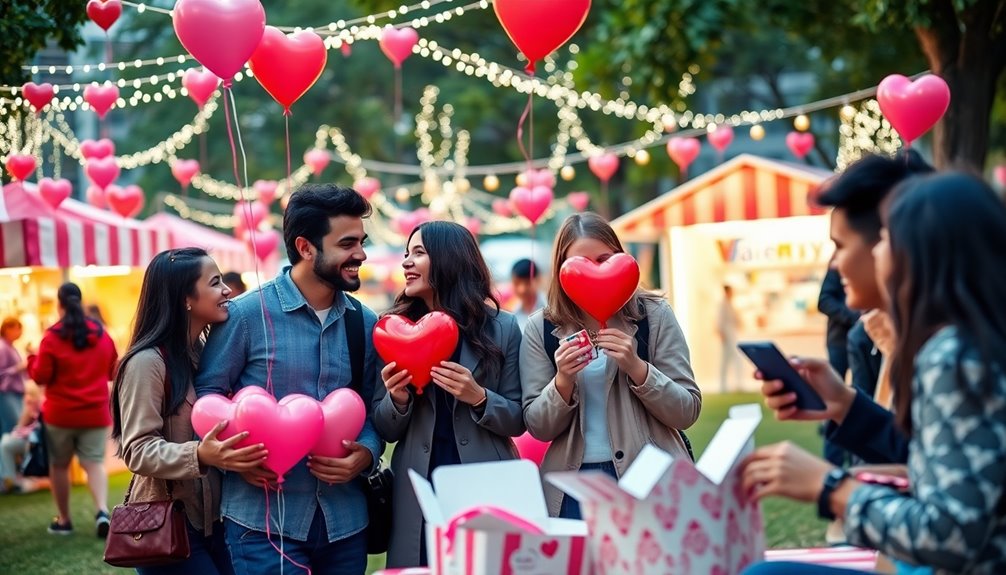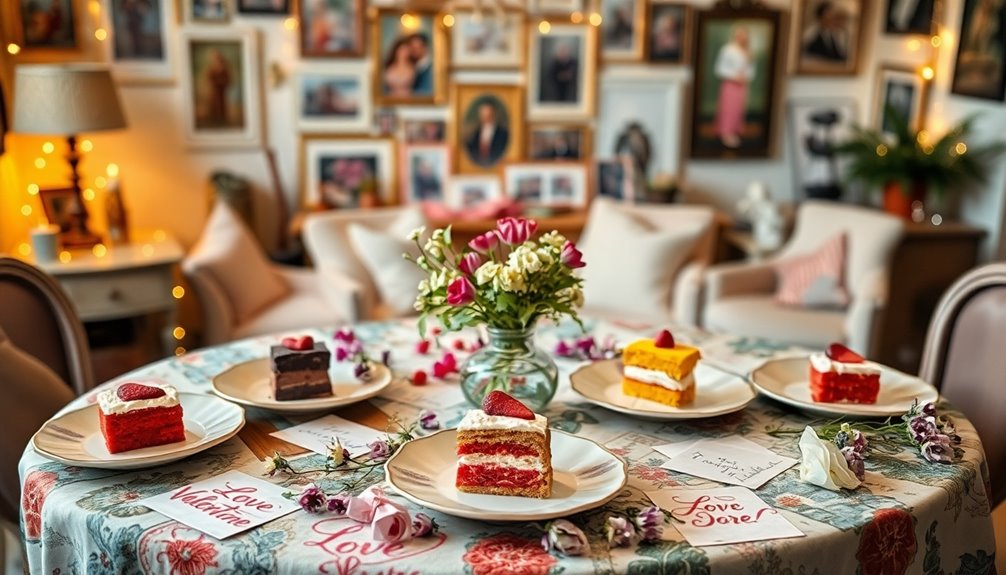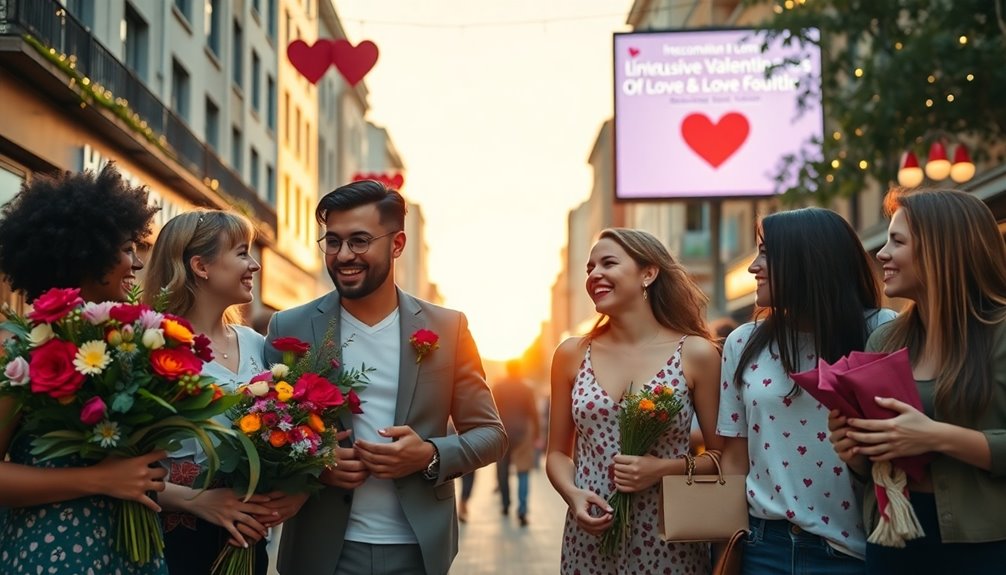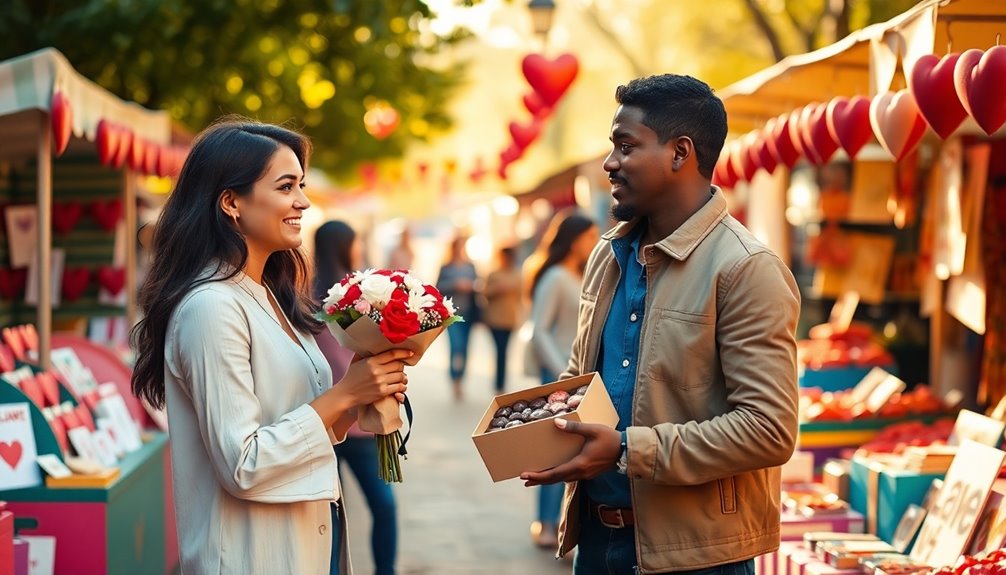Cultural shifts are reshaping how you celebrate Valentine's Day. Gone are the days of just lavish gifts; today, love comes in many forms—romantic, platonic, and self-love. People are focusing on personalization and meaningful gestures instead of commercialism. Celebrations like Galentine's Day highlight friendships, while traditions vary globally, promoting inclusivity. These changes reflect a broader understanding of love and relationships. Keep exploring to uncover how these evolving traditions are redefining the significance of this special day.
Key Takeaways
- Valentine's Day has evolved from a festival of fertility to a broader celebration of various forms of love, including platonic and self-love.
- Commercialization pressures individuals to equate love with expensive gifts, prompting a shift toward more meaningful, personalized expressions of affection.
- Alternative celebrations, like Galentine's Day and el Día del Amor y la Amistad, promote inclusivity by recognizing love among friends and family.
- Emphasizing shared experiences and thoughtful gestures enhances relationship satisfaction and fosters authentic connections beyond traditional romantic expectations.
- Open communication regarding relationship expectations and evolving gender roles is essential to navigate the pressures of modern Valentine's Day celebrations.
The Historical Origins of Valentine's Day

While you might think of Valentine's Day as just a modern celebration of love, its origins trace back to ancient times, specifically the Roman festival of Lupercalia, celebrated from February 13-15.
This festival included fertility rituals and matchmaking lotteries that laid the groundwork for romantic associations. The day evolved further after the martyrdom of St. Valentine, who defied Emperor Claudius II's marriage ban, cementing February 14 as a day for love.
By the Middle Ages, Valentine's Day traditions shifted to celebrate courtly love, marked by exchanging love notes, or billets-doux.
Influenced by Geoffrey Chaucer, the association of this day with romantic love flourished, showcasing the cultural influences that shaped its evolution over centuries into the beloved celebration we recognize today.
The Modern Commercialization of Love

As Valentine's Day approaches, you can't help but notice how love has become a multi-billion dollar industry. The commercialization of Valentine's Day now exceeds $20 billion annually, with consumer pressure creating societal expectations that equate love with extravagant gifts. This shift from personalized notes to mass-produced cards marks a significant change in how we express affection.
| Item | Price Range | Environmental Impact |
|---|---|---|
| Flowers | $20 – $150 | High |
| Greeting Cards | $3 – $10 | Moderate |
| Chocolates | $5 – $100 | Low |
| Jewelry | $50 – $5000 | High |
| Dinner Reservations | $50 – $500 | Moderate |
These trends often alienate those who can't participate in this consumer culture, prompting discussions around ethical consumerism. The rise of ethical consumerism reflects a growing desire for more meaningful and sustainable expressions of love.
Expanding the Definition of Love

In today's world, love isn't just about romantic relationships; it encompasses a wide array of connections that enrich our lives.
Valentine's Day has evolved to celebrate not only romantic love but also platonic, familial, and self-love. This expanding definition of love highlights the importance of diverse relationships, like those celebrated on Galentine's Day, which honors female friendships.
Cultures worldwide, such as Mexico's el Día del Amor y la Amistad, promote togetherness among friends and family, reinforcing that love comes in many forms.
By embracing inclusivity, you can express gratitude and affection without the pressure of traditional romantic expectations.
As society shifts, we increasingly value emotional connections and kindness, moving beyond material gifts and romantic gestures in our celebrations of love. Additionally, traditional healing practices within Indigenous cultures emphasize the significance of community and connection, further enriching our understanding of love and relationships.
Personalization and Authenticity in Celebrations

When it comes to celebrating love, putting thought into your gifts can make all the difference.
Unique traditions and personalized gestures not only show you care but also create lasting memories that go beyond typical expectations.
Let's explore how these meaningful touches can enhance your romantic celebrations.
Thoughtful Gift Ideas
Thoughtful gift ideas have the power to transform ordinary celebrations into extraordinary moments, especially when they focus on personalization and authenticity. Instead of opting for generic gifts, think about thoughtful gestures that reflect your partner's interests or your shared experiences.
Personalized gifts, like custom jewelry or handwritten letters, can carry immense sentimental value, as over 60% of people believe. Additionally, embracing experiences—like cooking a favorite meal together or planning a surprise outing—can shift Valentine's Day from a commercialized event to a meaningful celebration.
Research shows couples who engage in these personalized celebrations report higher relationship satisfaction. By prioritizing heartfelt gestures over materialism, you not only enhance feelings of love but also create lasting memories together. Moreover, incorporating thoughtful gestures can greatly strengthen emotional bonds, similar to how couples benefit from positive co-parenting strategies after divorce.
Unique Celebration Traditions
While many couples stick to traditional celebrations, embracing unique rituals can deepen your connection and make the occasion truly memorable.
By incorporating personalized experiences, you can express love in ways that resonate with both you and your partner.
Consider these unique traditions that foster authenticity:
- Cooking a special meal together
- Creating a scrapbook of your favorite memories
- Writing love letters to exchange
- Planning a themed movie marathon
- Celebrating Galentine's Day with friends
These alternative celebrations allow you to transcend societal norms and focus on what truly matters.
Thoughtful gestures, tailored to your partner's interests, will create cherished memories and strengthen your bond, making each Valentine's Day unique to your relationship. Additionally, understanding emotional dysregulation can enhance your ability to connect with your partner during these personal celebrations.
Societal Expectations and Relationship Dynamics

As societal expectations shape relationship dynamics, many find themselves maneuvering the pressures tied to occasions like Valentine's Day. This day often amplifies societal norms, where extravagant gifts and grand gestures become the standard for expressions of love.
The commercialization of the holiday can make love seem like it's measured by financial expenditure rather than genuine sentiment. To navigate these pressures, open communication about each partner's expectations is essential. This helps prevent misunderstandings and alleviates the burden to conform.
Additionally, recognizing that not everyone adheres to traditional romantic practices fosters an understanding of love that respects diverse views. Embracing these differences can strengthen relationships, allowing partners to celebrate love in ways that feel authentic and meaningful to them. Prioritizing balanced nutrition can also enhance emotional well-being, contributing positively to relationship satisfaction.
Gender Dynamics in Gift-Giving

When it comes to gift-giving, society's expectations often place women in a challenging position, especially during occasions like Valentine's Day.
You might notice cultural shifts that challenge these traditional roles, as more people seek to redefine how love is expressed. As romantic practices evolve, it's important to reflect on how these changes impact gender dynamics in gift-giving. This evolving landscape allows for unconditional father-daughter love to be celebrated beyond traditional gestures, as both partners embrace the opportunity to express their affection in diverse and meaningful ways.
Gift-Giving Expectations Explained
Gift-giving in romantic contexts often reveals deep-seated gender dynamics that shape expectations and behaviors. In many cultures, traditional gender roles dictate who gives and who receives, leading to burdensome gift-giving expectations.
For instance, in Japan, women often feel pressured to provide chocolates, while men must reciprocate lavishly on White Day. This imbalance can foster resentment and emotional strain.
- Financial stress from obligatory gifts
- The joy of true mutual appreciation
- The weight of societal expectations
- The freedom of opting out
- The desire for equitable practices
Recognizing these dynamics is essential as we navigate modern relationships. Additionally, understanding the impact of divorce rates can further highlight how these expectations may influence relationship satisfaction and outcomes.
Embracing mutual appreciation can transform gift-giving into a more meaningful expression of love, rather than a chore dictated by outdated norms.
Cultural Gender Roles Shift
Maneuvering the complexities of gift-giving often reveals deeper cultural shifts in gender roles. In Japan, women traditionally give chocolates, categorized by obligation or true feelings, while some opt out due to the associated burdens. In South Korea, the roles reverse, with men reciprocating gifts on White Day. This emphasizes changing expectations around romantic expressions.
| Country | Gender Role on Valentine's Day | Gift-Giving Tradition |
|---|---|---|
| Japan | Women give chocolates | Obligation vs. true-feelings |
| South Korea | Women give gifts | Men reciprocate on White Day |
| Western Cultures | Women face pressure | Feminist critiques on romantic norms |
These shifts highlight the need for a more equitable approach to gift-giving in modern romance.
Evolving Romantic Practices
As societal norms evolve, so do the practices surrounding romantic gestures, particularly in gift-giving. In Japan, women often bear the weight of gifting chocolates, feeling both financial and emotional pressure. This dynamic can lead to a reevaluation of traditional expectations, especially with the introduction of "White Day," where men reciprocate gifts.
Similarly, in Western cultures, feminist critiques highlight the pressure on women to conform to romantic ideals, challenging the norms of gift-giving.
- Love should feel light, not burdensome.
- Mutual expressions of affection build stronger connections.
- Gender roles shouldn't dictate how love is shown.
- Gifts can be simple yet meaningful.
- Everyone deserves to feel valued and appreciated.
These evolving romantic practices reflect a shift towards equality and shared love, emphasizing the importance of emotional alignment in fostering genuine connections.
Resistance and Redefinition of Valentine's Traditions

While Valentine's Day is often viewed as a celebration of romantic love, many cultures are pushing back against its traditional narrative. In countries like Pakistan, despite official bans, young people still find ways to celebrate, highlighting a clash between cultural values and global influences.
In India, protests reflect the struggle between local authenticity and Western customs. Meanwhile, alternative celebrations like Singles Awareness Day and Galentine's Day promote resistance to the conventional romantic focus, emphasizing inclusivity in recognizing diverse relationships.
South Korea uniquely redefines Valentine's traditions with specific days for gift-giving, showcasing a broader acceptance of various love forms. These shifts indicate a cultural redefinition, embracing a more inclusive view of love that transcends traditional romance. Furthermore, the emotional turmoil experienced by individuals in various types of relationships can lead to a greater understanding of rebuilding trust and confidence in a broader context of connection and intimacy.
Frequently Asked Questions
How Have Valentine's Day Traditions Changed Over Time?
Valentine's Day traditions have changed considerably over time. You might've noticed that it's no longer just about romantic love; now, it celebrates all kinds of relationships.
You can send cards to friends or even treat yourself on Galentine's Day.
Commercialization has also transformed the holiday, with gifts and experiences becoming the norm. This shift reflects broader societal changes, allowing everyone to express love in ways that resonate with their unique situations.
How Is Valentine's Day Celebrated in Different Cultures?
Imagine a world where love is celebrated in delightful and unique ways.
In Japan, you'll find women gifting chocolates to men, while South Korea hosts singles' gatherings on Black Day.
Mexico invites everyone to share love on el Día del Amor y la Amistad, and in Finland, you'll celebrate friendships.
Meanwhile, in Wales, hand-carved wooden spoons symbolize affection.
Each culture adds its own flavor to this universal celebration of love and connection.
How Did Valentine's Day Become Associated With Romance?
Valentine's Day became associated with romance due to its historical roots in courtly love and the ideals of chivalry.
You can trace its evolution from a solemn feast honoring Saint Valentine to a celebration focused on love.
How Is Valentine's Day Celebrated Nowadays?
Valentine's Day nowadays feels like a love explosion, with everyone celebrating in their own unique ways!
You might find yourself exchanging heartfelt cards, indulging in fancy dinners, or even gifting quirky presents.
In some places, you celebrate friendships instead of romance, while others embrace the joy of being single.
No matter how you choose to celebrate, it's all about expressing love, whether it's for a partner, friends, or family.
Conclusion
As you navigate the colorful landscape of modern romance, remember that love isn't confined to a single day or tradition. Picture a vibrant tapestry, woven with threads of authenticity and personal meaning, where each celebration reflects your unique journey. Whether it's a heartfelt handwritten note or a spontaneous adventure, embrace the freedom to redefine what Valentine's Day means to you. In this evolving narrative, let love bloom in all its forms, shining brighter than any commercialized token.









